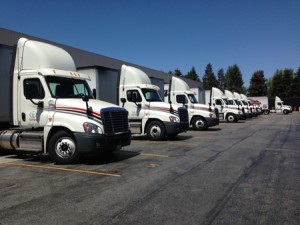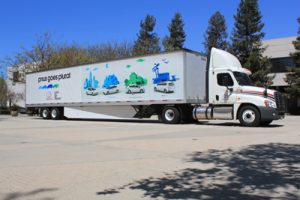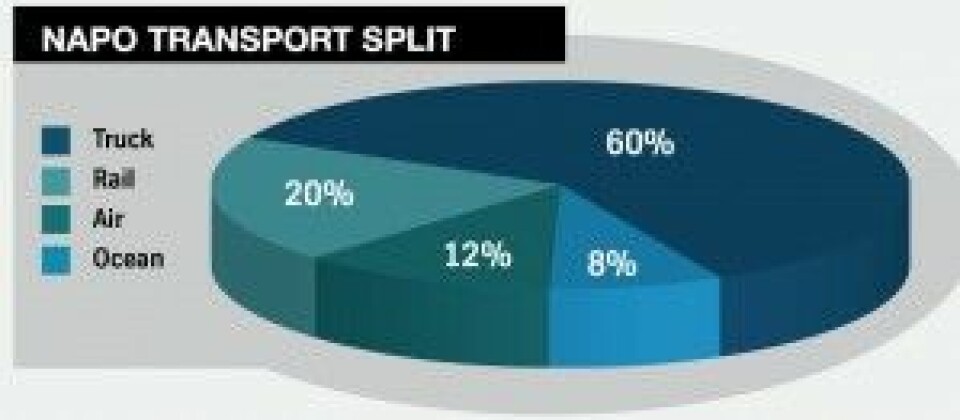Toyota part 3: On time, any time, all of the time
 Run with the precision of its famed production system, transport management forms the backbone of Toyota’s service parts distribution, with daily, multimodal services, and strong controls over expedited freight
Run with the precision of its famed production system, transport management forms the backbone of Toyota’s service parts distribution, with daily, multimodal services, and strong controls over expedited freight
Toyota’s North American Parts Operations (NAPO) division manages a complex set of transport flows designed to allow for the latest possible dealer orders of parts that will arrive the next day by 7am, with other set times for expedited orders. Here, again, the network has proven remarkably resilient, according to head of NAPO Neil Swartz, with an on-time delivery record for orders, adjusted for damage and warehouse errors, of 99.89%.
In five part series, see also...
Part 1
- Cornerstone of a strong supply chain (published March 20th)
- NAPO and becoming ‘One Toyota’ (published March 20th)
Part 2
- Inside the warehouses (published March 24th)
Part 3
- Engineering transport flows (published March 30th)
- In-house fleet and apps (published March 30th)
- Reverse logistics opportunities (published March 30th)
Part 4
- Understanding dealer orders (published April 7th)
Part 5
- Delivering the Toyota Way (published April 10th)
- Genchi Genbutsu at Long Beach (published April 10th)
To make such service possible, NAPO and its partners have engineered logistics with the precision of the Toyota Production System, while also creating flexibility in expediting parts through the supply chain when they are not immediately available in nearby parts distribution centres.
In Toyota’s ‘two-tier supply chain’, NAPO manages transport flows inbound to the parts centres in Kentucky and California, and from these facilities onward to regional PDCs and distributors across North America and beyond. For the PDCs it owns or controls, NAPO is also responsible for final delivery to dealers. Finally, NAPO manages reverse logistics for returnable packaging and returned parts, and is trialling taking control of remanufactured parts.
NAPO works with 45 trucking, intermodal and air carriers, along with an in-house truck carrier, Toyota Quality Parts Express (TQPE).
Trucking services account for 60% of Toyota’s logistics budget across all the inbound and outbound routes that it manages in North America, with rail accounting for 20%, air freight 12%, and ocean freight 8%, says national manager for corporate logistics, Thornton Oxnard. In volume terms, however, the split is considerably more weighted towards road, as NAPO’s network, not unlike Toyota’s inbound production logistics, uses a variety of full truckload, less-than-truckload, milkrun, dedicated delivery and break-bulk road services.
Engineering inbound logistics flows
Toyota’s highest network efficiency tends to be for its inbound and inter-facility routes, including inbound from suppliers to the California or Kentucky part centres, or deliveries from those centres to PDCs. With a high density across each mode, many parts move in full truckloads and milkruns, as well as intermodal rail for distances greater than 700 miles (1,100km). From the Ontario parts centre, for example, standard orders move by road along the US west coast and as far as Texas, but by rail to its other destinations in the eastern US, Mexico and Canada.
Within these flows, Toyota is constantly looking to improve its costs and service. While it does outsource routing to its logistics carriers, NAPO monitors locations and volume carefully to assess where it needs to make changes, especially in areas such as dedicated delivery services (DDS).
[sam_ad id=6 codes='true']“The logistics routing is a factor of destinations, volume and density,” says corporate manager Mamie Warrick. “We create the service level model for each PDC and then use providers’ systems for routing. However, we constantly monitor the network to see that it is working and where we need to make optimisations.”
One example is for Toyota’s inbound supplier routes to its main part centres. According to Oxnard, less-than-truckload freight moving to Kentucky is currently divided between six different carriers. However, Toyota is in the process of switching to one provider to combine this material at a consolidation centre in Tipp City, Ohio, before moving in full truckloads to the Hebron centre.
 "[The Tipp City, Ohio] facility will act as a kind of separation centre for the PCK, sorting the material into more efficient truckloads. An added benefit is that the provider is also an inbound carrier for Toyota plants, so there may be room for synergies"
"[The Tipp City, Ohio] facility will act as a kind of separation centre for the PCK, sorting the material into more efficient truckloads. An added benefit is that the provider is also an inbound carrier for Toyota plants, so there may be room for synergies"
- Thornton Oxnard, Toyota
“This facility will act as a kind of separation centre for the PCK, sorting the material into more efficient truckloads,” says Oxnard. “An added benefit is that the provider is also an inbound carrier for Toyota plants, so there may be room for synergies.”
The company is also constantly working on increasing pack density of shipments at part centres. For example, bumper covers from Japan arrive at the Ontario parts centre and are transhipped into trailers before teams fill in available space around them with smaller items. As a result, Toyota has been able to eliminate as much as a full container load per shipment to each PDC destination, according to Don Thill, national manager at the parts centre. However, the extra time to pack the trailer must be measured against logistics savings, as it doesn’t always add up for high volume, closer destinations.
“We are not doing density to LA or San Francisco because there is such a quick turnaround and the locations absorb the space,” says Thill. “However, we do density work to destinations like New York, Baltimore and Boston because they have longer lead times, and the logistics savings are greater than the extra labour costs.”
Moves in the night – or the day
Deliveries to dealers are by their nature more variable in volume and density. Dealers order parts daily from NAPO, with most receiving shipments five days a week. However, orders tend to be highest on Monday and Tuesday, before declining as much as 20% later in the week. “We have to build our fleet around the highest demand points, so sometimes there is excess capacity on certain days,” admits Swartz.
The company is looking for countermeasures to such inefficiencies; it has even begun combining routes with other OEMs on some DDS, while in future it will start using the return leg of other routes to move parts for recycling.
For dealer deliveries, however, reducing order-to-arrival times has priority over logistics costs (up to a point). Toyota has an ambitious target of keeping the time between dealer orders and part arrivals limited to 15 hours; given that most dealers receive their parts by 7am, that would mean last order times of 4pm the previous day. These cut off times vary by region and route: from the Los Angeles PDC, dealers within the Los Angeles Basin can order standard next-day delivery up to 5pm, while those in San Diego, Las Vegas and Arizona can do so until 4pm.
NAPO’s shortest available order-to-arrival period for standard orders is currently 13 hours. “We are achieving the target of 15 hours in all but 200 out of our 1,400 dealers,” says Swartz.
Later orders are actually preferred in some ways, as distribution centres can build truckloads and include more customers on their routes. “There is a sweet spot around 4pm when we want the dealers ordering,” says corporate manager Mike Schober. “The later cut-off time we give them, the more opportunity to pick up those customers that come in later in the afternoon and fill our trucks.”
Toyota has already made a number of changes to allow for later orders, including extended hours or extra shifts at part centres. However, Swartz and his team have taken even bolder steps: since 2011, NAPO has been rolling out a service that allows many dealers to order and receive parts on the same day.
The ‘Same Day Service’ has two approaches: remote drop locations in which dealers retrieve their orders, as well as ‘will call’ availability at PDCs that allow nearby dealers to retrieve parts directly at the warehouse. Toyota now has remote drop-off services in 25 markets across a variety of routes in each, covering more than 340 dealers. Meanwhile, ten of its PDCs offer enhanced parts pickup times – including up to three slots per day – extending the reach by ten markets to 35 in total, and another 132 dealers, for 472 in total.
For same day delivery, dealers place an order by 10am or 11am, depending on location; the parts are packed at the local PDC and shipped to a central host dealer located within 2-3 hours drive of participating dealers. The delivery driver sends a text message to parts managers at dealerships to confirm the exact arrival time; participating dealers arrange their own drivers or shuttles to pick up the parts.
Dealers have the same 95% availability rate across the PDCs for the same-day service as for standard, although they cannot order hazardous materials, including hybrid batteries, which must be transported in special ways.
Including PDC parts pickup, dealers in the vicinity of participating PDCs could, in theory, receive the parts before 7am, receive another order later that day via a drop-off point, and even pick up a third order of parts directly from a PDC.
Unlike other deliveries, dealers participating in same-day service pay a monthly subscription fee for shared logistics cost based on their location. According to Swartz, dealers have not resisted the fee since the boost to their business is so significant, including the need for fewer loan vehicles.

“The programme has been very successful for us and the goal is to help dealers to return cars to customers on the same day; it helps dealers to better support sales opportunities in the service department, as well for wholesale parts demand,” says Swartz.
Last year, NAPO shipped more than 500,000 lines for same-day service, which Swartz expects to increase this year. The new Lexus PDCs in Atlanta and Orlando opening next year will also help to extend the reach of same day deliveries.
Managing referrals and exceptions
While Toyota’s network is highly planned, disruptions in supply – such as the west coast port slowdown – can lead to modal shifts and emergency shipments to part centres or directly to dealers. Toyota also has a carefully designed referral and urgent order system that expedites parts that are not immediately available – but which also considers costs.
Toyota can fill more than 95% of dealer orders from the nearest PDC. When it cannot, the order is checked against inventory across the network and referred to another location for fulfilment. Typically, the referral goes to either of the two parts centres in California or Kentucky, although it could also be from another PDC.
The referral process, if left unchecked, could lead to high rates of direct air freight. To reduce the dependency on more expensive shipping modes, stock replenishment referrals are promised to dealers within three days, rather than the standard overnight– unless dealers are willing to pay more. “Dealers can tell us that they want it in two days, or if ordering before 1pm, they can choose guaranteed, overnight delivery,” says Mike Schober.

It is within this order preference that NAPO engineers the most cost-effective methods and routes. Once the part is located, it moves by the transport mode appropriate to the chosen delivery time. The first preference would be to move the part from either of the two part centres by ground break bulk to the facing PDC, and then onward to the dealer. However, if the part is needed sooner, it may need to move by direct road from another PDC, or indeed by air break bulk, or even air to a dealer.
“That decision follows cost matched to the customer promise. For example, on the east coast there is a lot of ground break bulk between PDCs in New York, Baltimore, and Boston, because they are geographically close and we can fill a lot of orders that way between the three,” says Swartz. “On the west coast, there is some ground break bulk out of San Francisco, and a little out of Portland, but we mainly have to rely on air break bulk.”
Toyota even builds efficiency for transporting referrals within its inventory management. “For referrals, some of our surface freight is relatively inexpensive compared to others, and the inventory planner for the PDCs is quite aware of the options,” says Gordon Fogg, national manager for inventory. “He often designs his inventory plan where he knows there is going to be a referral to divert from the high-cost route into the low-cost route.”
The referral system also has a number of controls intended to avoid rushing the delivery of parts that may only be replenishment or stock. Toyota compares the order with inventory moving through the network, and if there is inbound freight to a PDC that can arrive and be put away at a dealer within 48 hours, based on Toyota’s forecast, NAPO will not refer the part, as that would not shorten the lead time for the dealer.
 "The goal [of same-day service] is to help dealers to return cars to customers on the same day; it helps dealers to better support sales opportunities in the service department, as well for wholesale parts demand"
"The goal [of same-day service] is to help dealers to return cars to customers on the same day; it helps dealers to better support sales opportunities in the service department, as well for wholesale parts demand"
- Neil Swartz, Toyota
“We call this ‘hold for arrival’. In these cases, we think the dealer is ordering parts for the shelf, rather than for a customer, and so we can avoid unnecessary referrals,” says Swartz.
The system is based on accurate inventory tracking lead-time forecasts, however, Toyota is also working on ways of refining the information from dealers to better distinguish between orders for replenishment and customers.
One way the company has reduced urgent shipments has been by holding slightly more inventory at PDCs, according to Fogg. For many PDCs and commodities, NAPO has increased the availability rate to more than 95%. “We tend to look at bulk parts first because of the storage implications that they have and how we can balance reducing safety stock with keeping them out of the air,” he says. “It’s very incremental and in some cases we focus just on a small group of part numbers at a specific PDC, but it makes a difference.”
However, depending on dealers’ needs, some orders must move by the fastest means possible. Toyota handles parts like these every day, including with ‘customer retention teams’ at each centre (this work is typically called ‘vehicle off road’ parts at other OEMs). Here, teams work in staggered shifts to catch the latest possible flights, pack items in cardboard, and ship them by UPS or FedEx directly to dealers. It is costly, but for NAPO ensuring the arrival of these parts is as much a part of a supply chain’s competitive advantage as is logistical stability and efficiency.
Truck photos by William Porter; Parts Centre by Jon Didier






